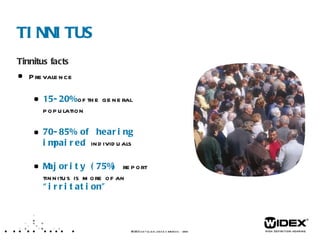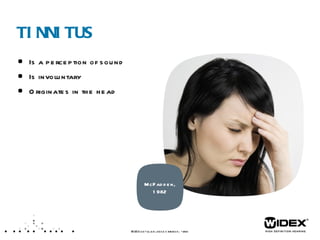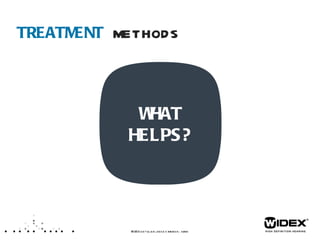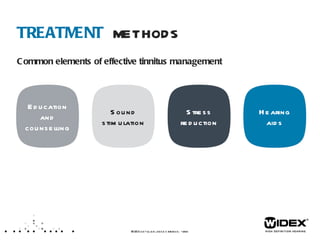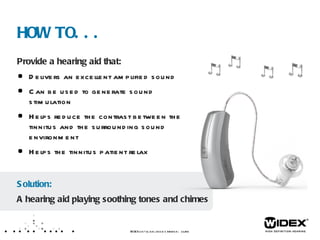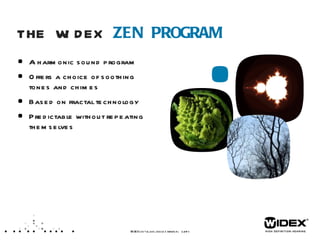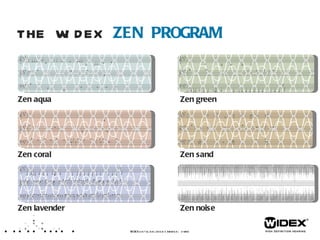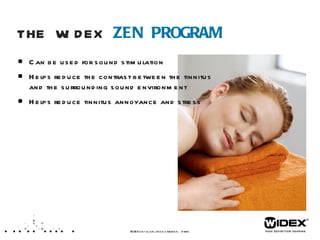Lets Talk Tinnitus
- 1. LET’S TALK ABOUT TINNITUS
- 2. General knowledge about tinnitus Prevalence, causes and treatment Widex tinnitus solution
- 3. TINNITUS Tinnitus facts Prevalence 15-20% of the general population 70-85% of hearing impaired individuals Majority (75%) report tinnitus is more of an “irritation” WIDEX LET’S TALK ABOUT TINNITUS /XX
- 4. TINNITUS Is a perception of sound Is involuntary Originates in the head McFadden, 1982 WIDEX LET’S TALK ABOUT TINNITUS /XX
- 5. TINNITUS Most common difficulties attributed to tinnitus Tinnitus is persistent Sleeping problems Speech understanding Despair, frustration, depression Inability to relax (stress) Concentration difficulties WIDEX LET’S TALK ABOUT TINNITUS /XX
- 6. THE CAUSE OF TINNITUS Large variety of suggested causes Generally accepted: tinnitus involves some kind of neural activity, interpreted by the brain as sound Where the spontaneous activity originates is much in dispute WIDEX LET’S TALK ABOUT TINNITUS /XX
- 7. TREATMENT METHODS Large variety of suggested causes generate large variety of suggested treatment methods WIDEX LET’S TALK ABOUT TINNITUS /XX
- 8. TREATMENT METHODS WIDEX LET’S TALK ABOUT TINNITUS /XX WHAT HELPS?
- 9. Common elements of effective tinnitus management TREATMENT METHODS WIDEX LET’S TALK ABOUT TINNITUS /XX Education and counselling Sound stimulation Stress reduction Hearing aids
- 10. TREATMENT METHODS Hearing aids Long recognized for reducing the effects of tinnitus Tinnitus relief can be the primary goal of hearing aids Hearing aids enhance the use of sound to manage tinnitus WIDEX LET’S TALK ABOUT TINNITUS /XX
- 11. Provide a hearing aid that: Delivers an excellent amplified sound Can be used to generate sound stimulation Helps reduce the contrast between the tinnitus and the surrounding sound environment Helps the tinnitus patient relax HOW TO... WIDEX LET’S TALK ABOUT TINNITUS /XX Solution: A hearing aid playing soothing tones and chimes
- 12. THE WIDEX ZEN PROGRAM A harmonic sound program Offers a choice of soothing tones and chimes Based on fractal technology Predictable without repeating themselves WIDEX LET’S TALK ABOUT TINNITUS /14
- 13. THE WIDEX ZEN PROGRAM Zen aqua Zen coral Zen lavender Zen green Zen sand Zen noise WIDEX LET’S TALK ABOUT TINNITUS /XX
- 14. THE WIDEX ZEN PROGRAM Can be used for sound stimulation Helps reduce the contrast between the tinnitus and the surrounding sound environment Helps reduce tinnitus annoyance and stress WIDEX LET’S TALK ABOUT TINNITUS /XX
- 15. THANK YOU!
Editor's Notes
- #3: In this presentation we are going to take a brief look at what is known about tinnitus – the prevalence of tinnitus, causes of tinnitus and treatment. Finally we are going to take a brief look at what we as a hearing aid company have to offer in this area. So.. Let’s talk about tinnitus....
- #4: First of all let’s look at some facts. If we ask the general population, 15-20% will reply that they have experienced tinnitus themselves, but what is very interesting from our point of view is that if we ask the same question to the hearing impaired population, the number increases significantly. 70-85% of the hearing impaired population reply that they have experienced tinnitus. Of all these people the majority report that tinnitus is more of an irritation than affecting their quality of life in general. When looking at these numbers, it makes great sense not only to focus on amplifying sounds for the hearing impaired population, but also try to address the tinnitus aspect. References: www.hear-it.org National center for health statistics
- #5: When looking into the literature on tinnitus, it is apparent that tinnitus is a very complex and highly disputed subject. A universally agreed definition has therefore not been reached, but McFadden’s definition from 1982 seems to be widely agreed upon. McFadden’s definition states that: Tinnitus is a perception of sound (it must be heard) Tinnitus is involuntary (not produced intentionally) Tinnitus originates in the head (not hearing or overly sensitive to an external sound) (cited in Tyler, 2005) Reference: Tyler, R. (2005) ed.: Tinnitus treatment, clinical protocols, Thieme.
- #6: When suffering from tinnitus, the sound in the ear is not the only problem – tinnitus is often accompanied by a range of complications with origins in persistent ringing in the ear and the fear that it will never stop. The most common difficulties attributed to tinnitus are sleeping problems, problems with speech understanding, despair, frustration and depression. Many report an inability to relax (stress) and concentration difficulties. References: Tyler, R.S., Baker, L.J. (1983): Difficulties experienced by tinnitus sufferers. J Speech Hear Disord. May;48 (2): 150-4.
- #7: So what is causing the ringing in the ears. When trying to answer this question, it is again apparent how tinnitus is a very complex and disputed subject. For the purpose of determining the cause of tinnitus, various neurophysiological models have been set up suggesting where tinnitus originates, but the only thing that there seems to be agreement upon is that tinnitus involves some kind of neural activity, interpreted by the brain as sound. Where this spontaneous activity originates is much in dispute. [neurophysiology is the study of the brain and human behaviour, growth, development and illnesses]. [Examples of theories of tinnitus origin Misinterpretation of small internal signals (Heller and Bergmann, 1953) Sensitivity in the central auditory system increases in the absence of sound (Hazell, 1987) Tinnitus has to do with otoacoustic emissions (Penner et al., 1989) Discordant damage of inner and outer hair cells (Jastreboff, 1990) Unorganised reorganisation associated with peripheral hearing loss (Salvi et al., 2000) Hyperactivity in the dorsal cochlear nucleus (Kaltenbach, 2001) ] References: Heller, M.F., Bergman, M. (1953): Tinnitus in normally hearing persons. Annals of Otology, 62, 73-93. Hazell, JWP. (1987): Tinnitus masking therapy. In: Hazell JWP. Ed. Tinitus. London: Churchill Livingston; 96-117. Penner, M.J, Bilger, R.C. Adaptation and the masking of tinnitus (1989). Journal of speech and Hearing Research. 32. 339-346. Jatreboff, P.J. (1990): Phantom auditory perception (tinnitus): mechanisms of generation and perception. Neuroscience Research. 221-254.) Salvi, R.J. Lockwood, A.H., Burkard, R. (2000): Neural plasticity and tinnitus. In Tyler R. Ed. Tinitus Handbook. San Diego: Singular. 123-148.) Kaltenbach J.A., Zhang, J., Zacharek, M.A. (2001) Neural correlates of tinnitus. In: Snow, J:B:, ed. Tinnitus: Theory and Management. London: BC Decker Inc. 141-161).
- #8: When turning to the treatment of tinnitus, it is apparent that the large variety of suggested causes generate a large variety of suggested treatment methods. Just by searching the internet you will find a tremendous amount of suggested treatments, some examples are: Cognitive-Behavioral Therapy Counselling Drug treatment Electrical stimulation ENT management Hearing aids Neuromonics Progressive Audiologic Tinnitus Management Tinnitus Masking Tinnitus Retraining Therapy Alternative and complementary methods etc. etc.....
- #9: So the big question is what actually helps among all these treatment suggestions?
- #10: To answer this question we have looked into the research to try and determine what the common elements of effective tinnitus management are. We found that: First of all: Education and counselling plays an important role in every type of tinnitus management. Some methods use counselling only, whereas others combine counselling with a different intervention modality. (Henry et al., 2008) Secondly: Most methods of tinnitus management incorporate the use of sound in some manner to reduce the negative effects of tinnitus. Some methods involve specific protocols and certain restrictions for using sound to manage tinnitus. Others take individual preferences and circumstances into account and use sound in a less strict manner. A universal counselling point within all the methods seems to be to maintain a background of constant low-level sound to reduce the contrast between tinnitus and the acoustic environment. And third: Stress reduction is used with great benefit in several tinnitus management procedures. Using soothing sound for tinnitus management can calm anxiety or nervousness that is associated with the tinnitus. Finally the use of hearing aids and amplification in itself has shown to be a very effective treatment of tinnitus. [References: Henry, J.A., Zaugg, T.L., Myers, P.J., Schechter, M.A. (2008): Using Therapeutic Sound With Progressive Audiologic Tinnitus Management. Anderssson G., Kaldo, V. (2006): Cognitive-Behavioral Therapy with applied relaxation. In R.S. Tyler (Ed.), tinnitus treatment: Clinical protocols (pp. 96-115). New York: Thieme. Henry. J.L., P.H. Wilson (2001): The psychological management of chronic tinnitus. Needham Heights, MA: Allyn & Bacon.]
- #11: As a hearing aid company we obviously have the hearing aids already. Hearing aids have long been recognized for reducing the effects of tinnitus and it has been shown how amplification as an adjunct to counselling facilitates tinnitus relief. Tinnitus relief can therefore be the primary goal of hearing aid use. Another apparent benefit of using hearing aids for tinnitus patients is that the hearing aids can enhance the use of sound to manage tinnitus by its amplification. But besides offering amplification for tinnitus sufferers, is there something else we can do? References: Kochkin and Tyler (2008): reported that >60% of tinnitus patients reported relief from use of hearing aids. Searchfield, G.D., Kaur, M., Martin, W.H. (2010): Hearing aids as an adjunct to counseling: tinnitus patients who choose amplification do better than those that don't . Int J Audiol. 2010 Aug;49(8):574-9. Bo, D. L., & Ambrosetti, U. (2007). Hearing aids for the treatment of tinnitus. Progress in Brain Research, 166, 341-345.
- #12: With the common elements of an effective tinnitus management in mind we went to the drawing board asking ourselves how to provide a hearing aid that [CLICK] not only delivers an excellent amplified sound, [CLICK] but can also be used to generate sound stimulation for the tinnitus patient, [CLICK] help reduce the contrast between the tinnitus and the surrounding sound environment, and [CLICK] help the tinnitus patient relax. [CLICK] The solution we came up with: A hearing aid that besides providing an excellent amplified sound is able to play soothing tones and chimes.
- #13: The soothing tones and chimes are gathered in a program in the hearing aid called the Widex Zen program. The Widex Zen program is based on fractal technology, which ensures that the Zen tones and chimes are rather predictable without repeating themselves. [CLICK: An example of a Zen-style is played] Let's talk about tinnitus - December 2010
- #14: There are six different Zen styles to choose from. Five are fractal tone programs with different combinations of pitch, tonality, dynamic range and tempo – adjustable to the hearing aid user’s preferences in the fitting software Compass. The sixth Zen style is Zen noise - a broadband noise to be used as a therapeutic sound as part of a tinnitus management procedure.
- #15: With the Widex Zen program we have – inspired by the most common elements of Effective Tinnitus Management – created a hearing aid feature that can be used for sound stimulation as part of a tinnitus management program, help reduce the contrast between the tinnitus and the surrounding sound environment and help reduce tinnitus annoyance and stress. And finally the hearing aid itself provides an excellent amplified sound across a broad frequency range – up to 10 kHz, which for some tinnitus sufferers might be enough to reduce tinnitus annoyance to an acceptable level.



